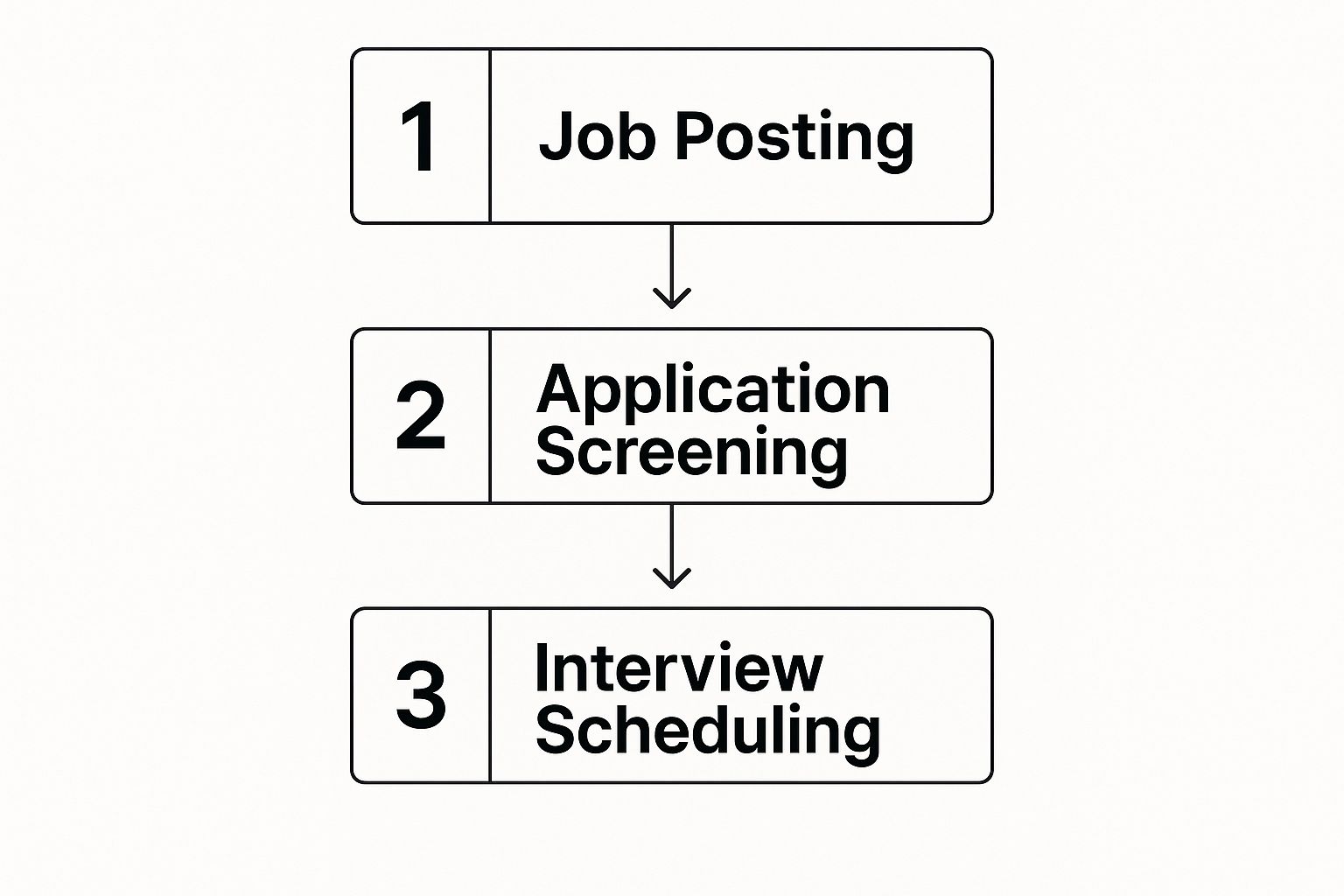Recruitment in human resource management is all about finding, attracting, and bringing on board the right people for the job. It's the very first—and arguably most important—step in building a team that can drive a company forward. Think of it as the engine that powers organizational growth by fueling it with the talent and skills needed to hit your business goals.
Recruitment as Your Strategic Growth Engine

Let's reframe how we think about recruitment. It’s so much more than just filling empty seats; it’s the strategic heart of your business.
Imagine your company is a championship sports team. Your recruitment process is the scouting operation—it’s not just about finding skilled players. It's about discovering individuals who will mesh with the team, enhance the culture, and contribute to the long-term vision.
This mindset shift is critical. When you move from simply filling a role to strategically acquiring talent, you start to see how recruitment directly fuels innovation, shapes your company culture, and ultimately drives your bottom line. Getting this first step right is the single best investment you can make in your company’s future.
The Economic Impact of Effective HR
The sheer economic scale of human resources tells you just how important it is. The global HR professional services market was valued at around USD 7 billion in 2024. It’s not stopping there; projections show it growing at a compound annual growth rate (CAGR) of 13.4% between 2025 and 2030.
By 2029, the market is expected to be worth an estimated USD 13.66 billion. This rapid expansion sends a clear message: businesses are investing serious money into getting their people processes right.
This financial boom highlights a fundamental truth: a well-oiled recruitment strategy is no longer a "nice-to-have." It’s a competitive necessity that lays the groundwork for everything else, from employee engagement and productivity to long-term retention.
A great vision without great people is irrelevant. Your recruitment process is the bridge between your company's ambition and its ability to execute. It's where potential becomes performance.
Beyond Filling Roles to Building Futures
A truly strategic approach to recruitment accomplishes things that go far beyond a single hire. It's about building a sustainable pipeline of talent that anticipates what you’ll need down the road, rather than just reacting to the opening you have today.
This forward-thinking mindset delivers some serious business advantages:
- Fuels Innovation: New talent brings fresh perspectives and diverse skills, preventing stagnation and sparking new ideas.
- Shapes Company Culture: Every single new hire either strengthens or weakens your culture. Strategic recruitment ensures you find people who align with your core values.
- Drives Business Performance: Putting the right people in the right roles has a direct and measurable impact on productivity, customer satisfaction, and profitability.
- Builds a Strong Employer Brand: A professional and positive candidate experience turns people into advocates for your company, boosting your reputation in the job market.
Of course, the world of HR is constantly changing, especially with technology. To get a better sense of where things are headed, check out this piece on Transforming Talent Acquisition with AI Recruitment. Keeping up with these shifts is crucial for staying ahead of the curve.
Solving Today's Talent Acquisition Puzzle

Let's be honest: finding the right people today feels less like a simple task and more like cracking a complex code. HR pros are wrestling with a tough market defined by talent shortages, glaring skills gaps, and fierce competition for every qualified candidate.
The game has fundamentally changed. Candidates are in the driver's seat now, and they know it. Things that used to be considered perks—like a great company reputation, a smooth application process, and a solid compensation package—are now just the table stakes to get top talent to even look your way.
The Numbers Behind the Hiring Headaches
Recent data really brings these challenges to life. In 2024, a staggering 77% of organizations reported struggling to fill full-time positions. While that’s a slight dip from the 91% peak in 2022, it shows just how widespread the talent crunch still is.
To make matters worse, nearly half (47%) of HR professionals admit that recruiting this year has been even harder than last year. The main culprits? Not enough applicants (60% of companies) and intense competition from other employers (55%). These numbers make it crystal clear: you need a thoughtful, compelling strategy to win people over.
The modern candidate is an informed consumer. They research company culture, read reviews, and evaluate your brand long before they ever click 'apply.' A poor reputation or a clumsy process will screen you out, not the other way around.
Navigating this reality means understanding what's causing the friction. The table below breaks down the biggest hurdles HR teams are facing right now.
Top Recruitment Challenges Faced by HR Professionals
| Challenge | Percentage of Companies Affected |
|---|---|
| Lack of Qualified Candidates | 60% |
| Competition from Other Employers | 55% |
| High Salary Expectations | 45% |
| Voluntary Employee Turnover | 35% |
| Candidate Ghosting | 46% |
These statistics paint a clear picture: the battle for talent is being fought on multiple fronts, from initial attraction to final offer.
The Rise of Candidate "Ghosting"
One of the most frustrating trends is the rise of candidate ghosting. A shocking 46% of organizations now say candidates are simply vanishing without a trace during the hiring process. This isn't just rude; it's a massive red flag signaling a disconnect between your process and what candidates expect.
When an application takes too long, communication is spotty, or your company's mission feels hollow, the best candidates won't wait around. They'll just move on to the next opportunity—and they have plenty of them. This is why focusing on the candidate journey is a non-negotiable part of any modern recruitment in human resources management strategy.
How to Stand Out in a Crowded Field
So, how do you get noticed when qualified candidates have their pick of employers? This is where your company’s identity becomes your most powerful recruiting tool.
Building a strong employer brand is absolutely essential. This goes way beyond a polished careers page; it's about telling a consistent story about your mission, your values, and what makes your company a great place to build a career. A deep dive into understanding employer branding can show you how to build this magnet for the right people.
For those in highly specialized fields like AI, another smart move is to partner with firms that live and breathe that niche. For instance, companies searching for very specific tech talent might look at the top recruiting companies for Automated Speech Recognition (ASR) services at https://ziloservices.com/blogs/top-10-best-companies-in-india-offering-staffing-and-recruiting-for-automated-speech-recognition-asr-services-2025/.
Ultimately, you can't solve today’s talent puzzle with yesterday’s playbook. It demands a sharp understanding of the market, a relentless focus on the candidate experience, and an authentic employer brand that connects with the kind of people you want to hire.
The Seven Stages of a Winning Recruitment Playbook
Great recruitment in human resources management isn't a one-off task; it's a meticulously planned process. Think of it less like a chaotic sprint and more like a perfectly executed relay race. Each stage needs to seamlessly pass the baton to the next, keeping the momentum going and ensuring everyone is on the same page from start to finish. This structured approach isn't just about efficiency—it guarantees fairness and dramatically increases the odds of finding the perfect person for the job.
Let's break down the seven core stages that turn an empty desk into a thriving new team member. This playbook is your roadmap for a consistent, effective, and human-centric hiring cycle.
Stage 1: Workforce Planning and Forecasting
Before you even dream of writing a job post, you need to zoom out and look at the big picture. This first stage is all about analyzing your current team, figuring out where the business is headed, and forecasting what skills you’ll need to get there. It’s about playing chess, not checkers—being proactive instead of just reacting to departures.
You need to ask some tough questions:
- Where is the company going in the next one to five years?
- What skills will we need to make that happen that we don’t have today?
- Are there people already on our team who could be trained to fill these future gaps?
This kind of strategic thinking stops you from making panicked hires and ensures every new role is a deliberate move toward your company's long-term goals.
Stage 2: Job Analysis and Description Crafting
Once you've confirmed a new role is necessary, it's time to get specific with a job analysis. This means breaking down the role's actual duties, responsibilities, and the qualifications someone truly needs to succeed. This is the foundational work that prevents you from chasing the wrong type of candidate.
With that analysis complete, you can craft a compelling job description. Remember, this isn't just an internal document; it's your first sales pitch to potential candidates. A great job description is clear, honest, inclusive, and gives a real taste of your company culture.
Stage 3: Sourcing and Attracting Candidates
With an awesome job description in hand, it's time to go find your people. Sourcing is an active hunt for qualified applicants, and it requires a multi-channel approach that extends far beyond just posting an ad and hoping for the best.
Effective sourcing strategies almost always include a mix of:
- Employee Referrals: Tapping into your current employees' networks is often the single best source for high-quality candidates who already have a sense of your culture.
- Social Media Recruiting: Using platforms like LinkedIn to connect with passive candidates—the talented folks who aren't actively job hunting but are open to the right opportunity.
- Company Career Pages: Making sure your own website offers a smooth, engaging, and easy-to-use application experience.
- Professional Networking: Getting out there, attending industry events, and building genuine relationships.
Many of these administrative tasks, like posting to multiple job boards or managing initial inquiries, can be automated. You can explore our guide on business process automation to see how freeing up your team from these tasks can give them more time for human connection.
Stage 4: Screening and Shortlisting Applications
As the applications start to pour in, the screening process kicks off. The entire goal here is to efficiently whittle down that large pool of applicants into a manageable shortlist of the most promising people.
This is where an Applicant Tracking System (ATS) becomes a recruiter's best friend. It helps organize all the applications in one place and can automatically filter candidates based on key criteria you set, like specific skills, keywords, or years of experience. This tech-assisted step ensures every application gets a fair look and lets your HR team focus their energy on the candidates who are the strongest match.
This infographic shows a simplified view of how sourcing and screening flow together.

As you can see, a structured process is all about moving candidates logically from the initial application phase toward the more hands-on interview stage.
Stage 5: Interviewing and Assessing Candidates
The interview stage is where the resumes come to life. This is your chance to get to know the people behind the paper. It should always be a two-way street—you're assessing their skills, experience, and cultural fit, but they're also interviewing you to see if your company is the right place for them.
Using structured interviews, where every candidate gets the same core set of job-related questions, is a fantastic way to reduce unconscious bias and make your comparisons far more objective. This stage might also involve practical skills assessments, a short presentation, or technical tests to really see what a candidate can do.
Stage 6: Making the Offer and Background Checks
After all the interviews and assessments, your hiring team makes its choice. The next step is extending a formal job offer, which should clearly lay out the salary, benefits, start date, and other key terms of employment.
The time between extending an offer and getting an acceptance is absolutely critical. Research shows that 49% of candidates have turned down a job because of a poor experience during the hiring process. Keeping up clear, enthusiastic communication here can make all the difference.
Once the candidate says "yes," it's time for the final checks. This usually involves verifying their employment history, talking to references, and, depending on the role, running a background check to ensure a safe and trustworthy workplace for everyone.
Stage 7: Onboarding and Integration
The recruitment process doesn't end when the contract is signed. A hire is only truly successful once the new employee is fully integrated into the team and the company.
A well-designed onboarding program is non-negotiable. It helps new hires get comfortable in their roles, understand the company culture, and start contributing much faster. This initial experience sets the tone for their entire career with your company and has a huge impact on their long-term engagement and retention.
Moving from Process to Performance with High-Impact Hiring
Having a recruitment process mapped out is one thing. Turning it into a high-performance talent engine is another entirely. This is where we move beyond just filling an open seat and start strategically adding people who will genuinely move the needle for the business.
Think of it like this: anyone can follow a recipe, but a great chef understands the ingredients and techniques so well they can create something truly special. The same goes for hiring. To attract the best people, you need to master a few key ingredients that shape who applies, who says "yes" to your offer, and how they feel about your company long before their first day.
Build an Employer Brand People Want to Be a Part of
Your employer brand is, simply put, your reputation. It’s what people say about you as a place to work when you're not in the room. This brand is built from every single touchpoint a potential hire has with your company—from a post they see on social media to the stories your current employees share with their friends.
A strong, authentic brand is like a magnet. It pulls in the right people, the ones who will thrive in your environment, and just as importantly, it helps those who wouldn't be a good fit self-select out.
The good news? You don't need a huge budget. Authenticity is your most powerful tool.
- Show, Don't Just Tell: Let your culture shine. Use your career page and social media to share real stories from your team. A short video of an engineer explaining a project they're passionate about is infinitely more compelling than a stock photo and a list of corporate values.
- Be Radically Transparent: Put your salary ranges in the job description. Seriously. The data is clear: job posts with salary info get far more eyeballs and applicants. Be upfront about your benefits and compensation philosophy.
- Own Your Online Reputation: Keep a close eye on sites like Glassdoor. Don't be afraid of negative reviews—respond to them thoughtfully. A well-handled piece of criticism can actually build more trust than a dozen glowing five-star reviews.
When you get your employer brand right, you turn people who are just passively browsing into genuinely interested candidates. It makes every other part of recruiting so much easier.
Write Job Descriptions That Attract and Convert
Your job description is arguably the most critical piece of marketing you'll create. It has to do two jobs exceptionally well: get a diverse group of qualified people excited about the role, and make sure it's easily found on Google and job boards.
The key is to think like a marketer, not an administrator. Ditch the endless laundry list of "must-have" qualifications that nobody actually meets. Instead, focus on the real-world impact the person in this role will have.
A job description should be an invitation, not a checklist of barriers. Words matter. Research has shown that masculine-coded language (think "rockstar," "ninja," or "dominant") can actively discourage highly qualified women and others from even applying. Focus on outcomes and use neutral language to open the door to a much wider talent pool.
Here’s how to get it right:
- Use Titles People Actually Search For: Scrap the internal jargon. A candidate is searching for "Software Engineer," not "Code Guru II." Use clear, standard titles.
- Sell the Impact, Not Just the Tasks: Instead of "Write code for new applications," try "Build features that will improve the daily lives of thousands of our customers." One is a task, the other is a mission.
- Run a Bias Check: Use a simple online tool to scan your job descriptions for exclusionary language. It’s a small step that can make a huge difference in the diversity of your applicant pool.
Master the Art of Social Media Sourcing
Social media isn't just for marketing your product anymore; it's one of the most powerful sourcing channels you have. Platforms like LinkedIn are goldmines for finding and connecting with passive candidates. These are the talented folks who aren't actively looking for a job but would be open to a great opportunity if it came along. And here's the kicker: a staggering 70% of the global workforce falls into this category.
But effective social sourcing isn’t about spamming people with connection requests and generic InMail messages. It’s about playing the long game. Build genuine relationships by sharing content that’s actually valuable to your target audience. Engage with their posts. Give them a real peek behind the curtain at your company culture.
This approach positions you as an employer they want to hear from. When a position finally opens up, you're not a stranger—you're a familiar name with a warm pipeline of talent already waiting. This personal touch is what truly sets apart exceptional recruitment in human resources management.
Using Recruitment Technology and AI Smartly

In today's world, technology isn't just an add-on for hiring—it's become a core part of modern recruitment in human resources management. From the moment you source a candidate to the day they're onboarded, smart tools are completely changing how companies find and connect with talent.
But let's be clear: this isn't about letting robots take over. It's about empowering your team. Think of recruitment tech as a force multiplier for your HR professionals. It takes care of the repetitive, high-volume tasks, freeing up your recruiters to focus on what humans do best: building relationships, gauging cultural fit, and making strategic hiring decisions.
Automating the Administrative Burden
At its heart, recruitment technology automates the grunt work. The most familiar tool for this is the Applicant Tracking System (ATS), which basically acts as a central hub for the entire hiring pipeline. It keeps candidate information organized, tracks where everyone is in the process, and helps schedule interviews so great people don't get lost in the shuffle.
But the automation doesn't stop there. AI-powered platforms can now:
- Source Passive Candidates: These tools are like digital headhunters, scanning professional networks and databases to find qualified people who aren't even looking for a new job but would be a perfect fit.
- Screen Resumes Intelligently: Forget simple keyword matching. Modern AI understands context, helping it pinpoint the most promising applicants with much greater accuracy.
- Schedule Interviews: AI schedulers can juggle the calendars of multiple interviewers and candidates, putting an end to those endless back-and-forth email chains.
This kind of automation can easily free up dozens of hours, time your team can now invest in having meaningful conversations with candidates.
Driving Smarter Decisions with Data
Beyond just making things faster, recruitment tech gives you the data you need to hire smarter. When you track the right metrics, you can stop relying on gut feelings and start building a strategy based on what actually works. The right data can show you where your process is getting stuck, which job boards are bringing in the best candidates, and how you can fine-tune your approach over time.
Technology has already made a huge impact on hiring. Right now, 79% of recruiters are using AI for screening candidates, and 53% of HR teams are boosting their automation budgets. AI has been shown to cut time-to-hire by 35%, and 37% of companies now use chatbots to engage with applicants. You can dig into more numbers in this overview of key recruitment statistics.
This pivot to analytics is a cornerstone of effective HR. For a closer look at this mindset, our guide on data-driven decision-making provides practical frameworks you can use across your entire organization.
Balancing Technology with the Human Touch
As powerful as these tools are, it's crucial to get the balance right. If you automate too much, your hiring process can feel cold and impersonal, which is a great way to turn off top talent and damage your employer brand. Technology should always support human connection, not replace it.
Here’s how to keep that balance in check:
- Automate Tasks, Not Relationships: Use tech for scheduling and initial screening, but make sure a real person is handling the important communication, giving feedback, and building rapport.
- Ensure Fairness and Mitigate Bias: AI is only as good as the data it's trained on. You need to regularly audit your tools to make sure they aren't accidentally filtering out diverse candidates.
- Personalize at Critical Touchpoints: An automated "thank you" email is fine, but a personal note from a hiring manager after a fantastic interview can make all the difference.
Ultimately, the smartest approach to technology in recruitment in human resources management is one where efficiency and empathy work together. Use these powerful tools to create a hiring process that's smooth, fair, and informed by data—but still feels fundamentally human.
Measuring What Matters in Recruitment
You can’t improve what you don’t measure. That old saying is the absolute bedrock of modern recruitment in human resources management. Moving past gut feelings and into a world of data is what separates a decent hiring process from a truly great one. This is how you prove the value of your work with cold, hard numbers.
Keeping an eye on the right Key Performance Indicators (KPIs) essentially gives you a command center for your entire talent acquisition process. It helps you find the weak spots, make a strong case for your budget, and constantly fine-tune your strategy. Let's dig into the metrics every HR team should be tracking.
Time to Fill
Time to Fill is one of the most basic, yet critical, recruitment metrics out there. It’s simply the number of days that pass from the moment a job requisition is approved to the day your chosen candidate signs on the dotted line. Think of it as the speedometer for your hiring engine.
If your Time to Fill is consistently high, that’s a red flag waving at you. It could mean trouble at any stage of the process.
- Are your job descriptions too vague and attracting unqualified applicants?
- Is your interview process a marathon that’s causing top candidates to lose interest?
- Are you stuck waiting ages for internal approvals to get an offer out?
By tracking this number, you can pinpoint exactly where things are getting bogged down and fix the leak. A faster Time to Fill means less downtime for your teams and a quicker path to full productivity.
Cost per Hire
Let’s be honest: every hire costs money. The Cost per Hire metric tells you exactly what that total investment is. This isn’t just about a recruiter’s salary; it’s a full accounting of all the internal and external expenses that go into finding and onboarding one new person.
To figure it out, just add up all your recruiting expenses—think ad placements, agency fees, referral bonuses, and software subscriptions—and divide that total by the number of hires you made in the same period.
Keeping a close watch on your Cost per Hire is essential for managing your budget and proving how efficient your team is. If the number is creeping up, it might mean you're leaning too heavily on expensive agencies or that your ad spend isn't hitting the mark.
For a deeper dive into controlling your spending, check out these practical strategies to reduce your recruitment cost per hire. This can help you get more bang for your buck without compromising on talent.
Quality of Hire
Speed and cost are important, but they’re pretty useless if the people you bring on board don't work out. That’s why Quality of Hire is arguably the most valuable—and the trickiest—metric of them all. It’s all about measuring the long-term value a new employee brings to the company.
Because "quality" can feel a bit subjective, it’s usually tracked by combining a few different data points once the new hire has settled in.
- Performance review scores
- Feedback from hiring manager satisfaction surveys
- Hard data on productivity (like hitting sales targets)
- Whether they’re still with the company after one year
A high Quality of Hire score is the ultimate sign that your entire recruitment machine—from sourcing and screening to interviewing and onboarding—is working exactly as it should be. It’s proof you’re not just filling seats, but finding genuine top performers who will help move the business forward.
Common Recruitment Questions, Answered
As you dive into the world of talent acquisition, a few key questions always seem to pop up. Let's tackle some of the most common ones to give you a clearer picture of recruitment in human resources management.
What’s the Real Difference Between Recruitment and Selection?
It’s easy to use "recruitment" and "selection" interchangeably, but they are two very distinct stages of the hiring journey.
Think of it like fishing. Recruitment is all about casting a wide net. It's the process of finding and attracting a pool of potential candidates—getting people interested enough to apply for your open role.
Selection, on the other hand, is when you start sorting through your catch. This is where you use interviews, skills tests, and reference checks to carefully evaluate your applicants and choose the single best person for the job.
How Can a Small Business Recruit on a Tight Budget?
You don't need a huge budget to find great people. For small businesses, the trick is to be smart and focus on high-impact strategies that don't cost a fortune.
Here are a few ideas that work wonders:
- Lean on Employee Referrals: Your best people often know other great people. A simple, well-structured referral program can become your most powerful source for high-quality candidates who already fit your culture.
- Create an Authentic Employer Brand: Use your website and social media to tell your company’s story. You don’t need a big marketing budget to showcase your team, your values, and what makes your workplace unique.
- Nail the Candidate Experience: Being respectful, communicating clearly, and providing timely feedback costs absolutely nothing. A fantastic experience can turn every applicant into a fan, even those you don't hire.
Is an Applicant Tracking System Really Necessary?
An Applicant Tracking System (ATS) might not be essential on day one, but it quickly becomes a lifesaver as your company grows. If you're consistently getting more than a few applications for each opening, an ATS will change the game for you.
An ATS automates the tedious administrative tasks, keeps your candidate pipeline perfectly organized, and helps with compliance. For any business that hires regularly, it saves a massive amount of time, stops great candidates from slipping through the cracks, and gives you the data you need to keep getting better at hiring.
At Zilo AI, we know that great people are the real engine of business growth. Our strategic staffing solutions connect you with the skilled professionals you need to build your teams and push innovation forward. Discover how our manpower and data services can help you scale at https://ziloservices.com.

